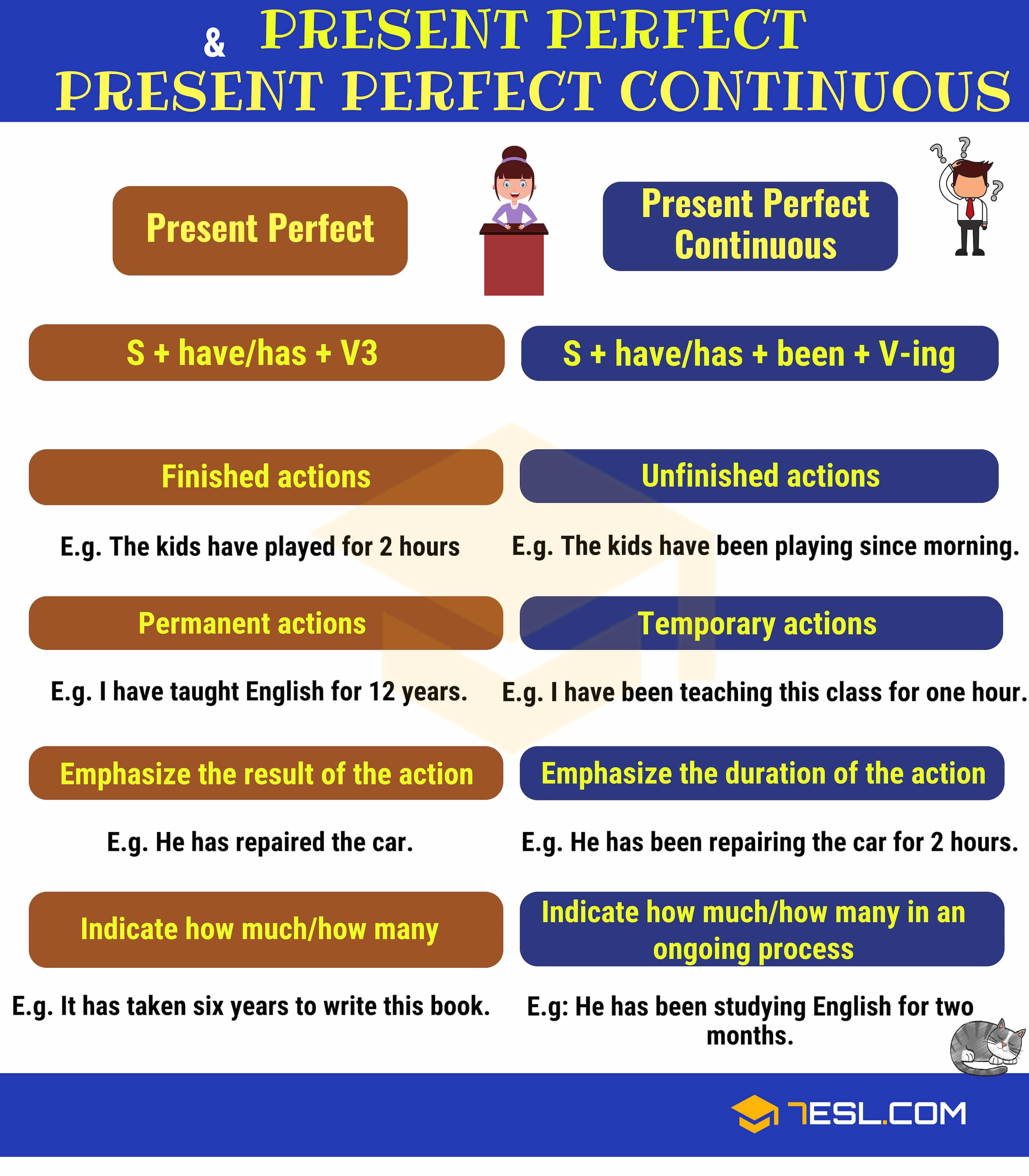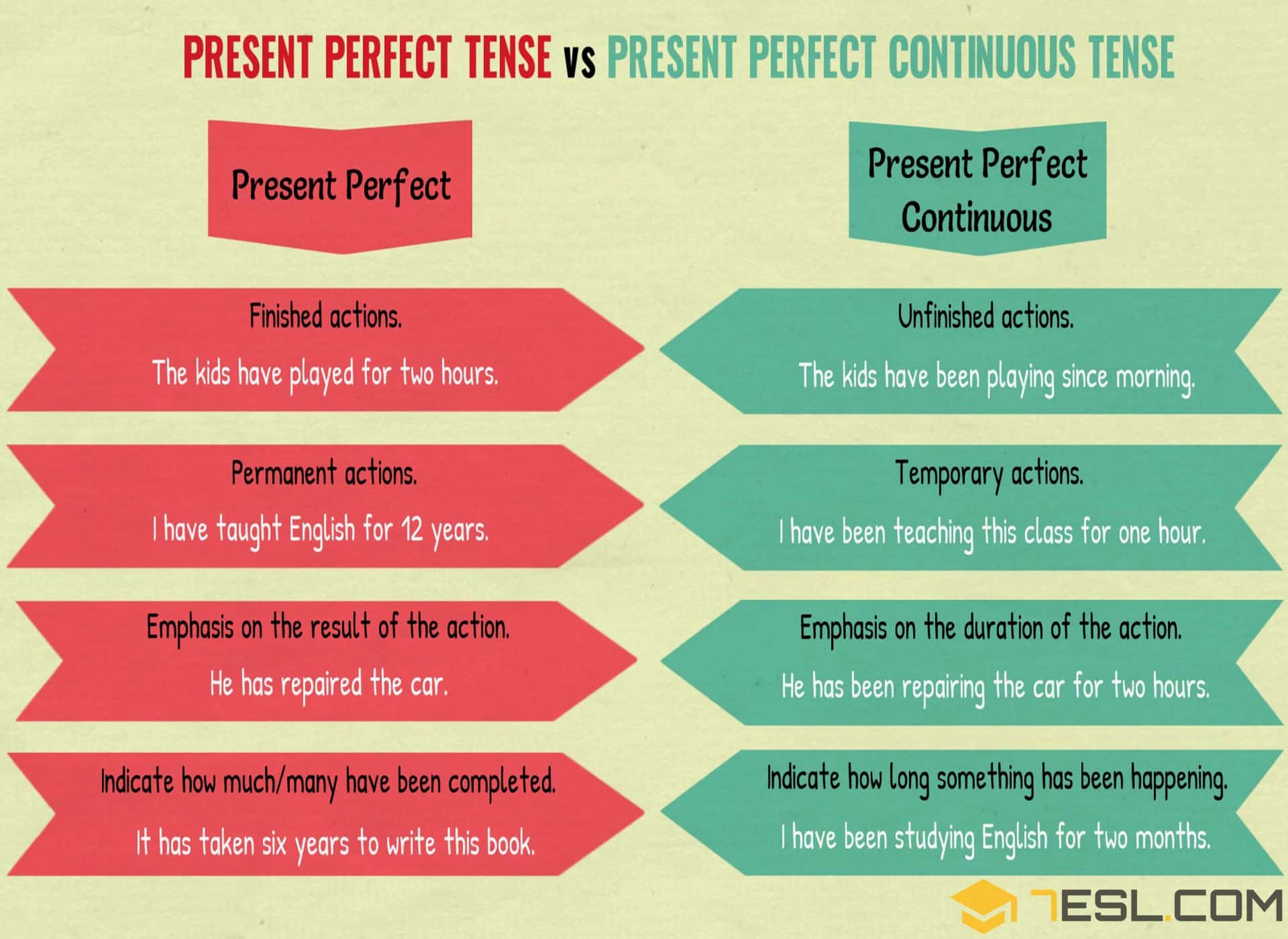Contents
In the reference, you will learn the differences between the present perfect and present perfect continuous tenses in English. This includes their forms and usage, providing helpful examples and grammar rules. You will also see a comparison picture to clarify the differences.

Present Perfect and Present Perfect Continuous | Form
- Formed by adding “have/has” to the past participle.
- Structure: S + have/has + V3.
- Formed by adding “have/has been” to the present participle.
- Structure: S + have/has + been + V-ing.
Present Perfect and Present Perfect Continuous | Usage
Present perfect simple tense is used with finished actions, while the present perfect progressive tense is used with unfinished actions.
- The kids have played for 2 hours. (present perfect simple)
- The kids have been playing since morning. (present perfect continuous)
Present perfect simple tense indicates permanent actions; the present perfect progressive tense describes temporary actions.
- I have taught English for 12 years. (present perfect simple)
- I have been teaching this class for one hour. (present perfect continuous)
Present perfect simple tense emphasizes the result of the action; In contrast, the present perfect progressive tense emphasizes the duration of the action.
- He has repaired the car. (present perfect simple)
- He has been repairing the car for 2 hours. (present perfect continuous)
Present perfect simple tense indicates “How much/How many”, while the present perfect progressive tense indicates “How long something has been happening”.
- It has taken six years to write this book. (present perfect simple)
- He has been studying English for two months. (present perfect continuous)

Present Perfect vs. Present Perfect Continuous | Note
Always use the present perfect simple with the verbs believe, know, understand, like/dislike, belong, own:
- We’ve known each other since we were kids.
- I’ve never understood math very well.
- He’s always liked sports.
- Active vs. Passive Voice Exercises – Active vs. Passive Voice Worksheet - December 25, 2023
- Phrase Exercises – Phrase Worksheet - December 23, 2023
- Sentence Exercises – Sentence Worksheet - December 23, 2023

I’m French, thank you very much, the presentation is pleasant, and the explanations aren’t confusing as they sometimes are with these times.
But I’m having trouble distinguishing a difference between :
Permanent action with the simple form :
I’ve been teaching English for 12 years
and unfinished action with the continuous form.
We can also consider that the action of teaching is still ongoing, can’t we?
I can tell you that the difference between the simple form and the continuous form is related to the aspect of the verb. The simple form is used to describe a completed or permanent action, while the continuous form is used to describe an ongoing or unfinished action.
In the example you provided, “I’ve been teaching English for 12 years,” the use of the present perfect continuous form “have been teaching” indicates that the action started in the past and is still ongoing in the present. This implies that the speaker is still teaching English at the moment.
On the other hand, the simple present form “I teach English” would imply that the action is a permanent or habitual action. It suggests that the speaker has been teaching English for a long time and will continue to do so in the future.
So, to answer your question, you can consider the action of teaching as ongoing in both cases, but the use of the continuous form emphasizes the ongoing aspect more strongly.
Thank you very much!
It well organized and Easy to learn!!
thank you, your website is so good to learn.
Aya
This site is very useful especially for an ESL teacher like me. Thank you so much for this and more power!
I have been learning English in this website since 2018
WoW
I have learned English today on your website.
I do like your website, and I think I will learn more grammar with it, please follow me up.